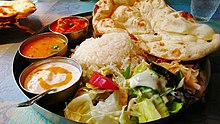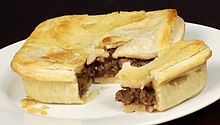Vegetarian cuisine
The vegetarian cuisine means a diet and its food that, with the exception of dairy products , eggs and possibly honey , deliberately avoided animal foods. While the ideological term vegetarianism as such only emerged in England in the 19th century, similar diets have existed for much longer. In addition to individual values, food taboos and nutrition and health teachings, they also go back to the guidelines of religions and religious directions that promote the renunciation of meat permanently or temporarily.
The adjective vegetarian is also used to describe traditional dishes that have been changed by omitting animal products or using various meat substitute products .
In addition to plant-based foods, an ovo-lacto-vegetarian diet also includes eggs and dairy products, while ovo-vegetarian or lacto-vegetarian foods only include eggs or only dairy products.
In the strictly vegetarian or vegan cuisine , all products of animal origin are left out. Vegans try to get along as far as possible without animal products in their lifestyle. The health effects of such a diet are controversial.
Historical and regional backgrounds
In addition to health and ethical-moral causes, according to Albert Wirz , the trend towards vegetarianism even before the First World War was a reaction to the upheavals caused by industrialization and globalization at the time. In addition to a frequent rejection of meat, different types of preparation were also propagated, for example in the various nutritional teachings of raw food or whole foods . In the sense of Pierre Bourdieu's main work The Subtle Differences , taste preferences are used as a cultural and social means of distinguishing different social groups. Modern vegetarianism was based on parts of the upper classes who, popularly mocked as " kohlrabi apostles ", combined ideas of food and the body with a general criticism of civilization and approaches to a broad reform of life . The German-speaking area played an important role in this. The International Vegetarian Union (IVU) was founded in Dresden in 1908 . The German Vegetarian Association , founded in 1867 in Nordhausen, Thuringia , is the second oldest vegetarian association in the world.
According to Peter Brang , vegetarian cuisine, corresponding restaurants and associations also played an important political role in Tsarist Russia, since a vegetarian way of life modeled on Tolstoy was considered a hallmark of the intellectual political opposition. The old Russian cuisine already made a distinction between meat and vegetables as well as fasting (vegetarian, mushrooms and fish) and festive dishes (meat, butter, eggs, milk) and had a large number of dishes suitable for vegetarians.
German and regional vegetarian cuisine
Classic representatives of German-speaking cuisine warn against designing vegetarian dishes as "malnutrition". Many southern German traditional vegetarian main dishes go back to the custom of offering a meatless main course during Lent and on fasting days. The combination of starchy foods such as potatoes and flour together with cheese and eggs as a source of protein instead of meat, such as in cheese fondue , Kässpätzle , vegetarian baked goods or Gaisburger March and dishes , is also popular and recommended .
The modern vegetarian kitchen differs from the traditional meat kitchen not only in the ingredients, but also set itself apart from a meatless and fasting kitchen early on through different methods of preparation and presentation. Restaurants that only offer strictly vegetarian or purely vegan cuisine are still not very common in Germany. Corresponding chefs like Chad Sarno are less interested in simply replacing animal products with others, but rather pay special attention to a u. a. The preparation based on molecular cuisine, which is intended to particularly enhance the taste experience.
International distribution of vegetarian cuisine

Diverse national cuisines such as Italian cuisine also have a number of dishes that are adaptable or suitable for vegetarians. Here are antipasti , pastas and pizzas just as a starter in a full menu sequence as they are served in vegetarian cuisine as well as the simple food and everyday cooking as a stand-up main courses.
Similarly, a large number of meatless dishes, starters and vegetable preparations from the Asian kitchens and in the oriental kitchens are adapted to the needs of vegetarians. Such dishes from the vegetarian cuisine can increasingly be found as a section in the classic menu cards.
An interest in high-quality vegetarian cuisine as well as high demands is expressed in the appearance of some vegetarian restaurants in German restaurant guides such as the Schlemmer Atlas . In top gastronomy, with the exception of a few pioneers such as Alain Passard , Rolf Hiltl and Pietro Leemann, top vegetarian chefs and their restaurants are almost not represented.
On long-haul flights, a vegetarian dish is often, but not always, part of the plane meal in addition to traditional meat dishes . Likewise, some armies offer military catering packages ( one-man packages ) for vegetarians.
In communal catering, vegetarian cuisine has the advantage that it does not fully comply with religious dietary regulations , but forms a kind of common denominator.
Ingredients for meat substitutes


Some plant-based foods are particularly suitable as meat substitutes. In addition to types of mushrooms such as Krause Glucke, this also includes types of cabbage and beet, which can be prepared as a full main course. Adaptations of specialties from German and Austrian cuisine include vegetarian schnitzel made from yacon , turnips and celery, as well as stew dishes such as vegetarian turnip stew . The fruits of the jackfruit tree also serve as a meat substitute.
In East and Southeast Asia, tofu and other soy products such as miso and yuba were traditionally used as a source of protein, condiments, cheese and meat substitutes. Different preparation forms such as tofu fried sausages, patties or soy milk or smoked products are available ready-made. Seitan and polenta preparations make it possible to replace meat with grain products of a similar consistency. Protein-rich legumes such as lentils , beans and peas and yeast products are also used as meat substitutes for spreads because, like meat, they contain high amounts of protein .
With strict vegetarians u. a. Avocado cream used for meat and eggs in cold dishes, nutritional yeast flakes as a substitute for cheese , yeast extract as a substitute for meat extract and eggs with mashed bananas and tofu as well as an increasingly starchy flour or special industrially manufactured egg substitute products and nut and vegetable oils as vitamin and substitutes Increasingly used flavor carriers.
literature
- Vegetarian cooking in over 100 variations. Parragon, ISBN 978-1-4054-7360-6 .
- Hans-Joachim Rose : Kitchen Bible - Encyclopedia of Culinary Studies. Tre Torri Verlag, ISBN 978-3-937963-41-9 .
- Erhard Gorys : The new kitchen dictionary. dtv, Munich 1994-2002, ISBN 3-423-36245-6 .
- Rolf Hiltl : Vegetarian as you please. ISBN 3-85932-492-6 . First published in 1998 for the 100th anniversary of the Swiss restaurant Hiltl (Restaurant) , is considered a "classic and standard work of vegetarian cuisine."
- Rose Elliot : Classic vegetarian cuisine. AT Verlag (April 2000), ISBN 3-85502-513-4 .
Individual evidence
- ↑ DGE : Is a vegetarian diet suitable for children? ( Memento of September 27, 2007 in the Internet Archive ) DGE-aktuell 14/98 of July 21, 1998
- ↑ Walter P., Baerlocher K., Camenzind-Frey E., Pichler R., Reinli K., Schutz Y., Wenk C. (eds.) Page no longer available , search in web archives: Health advantages and disadvantages of a vegetarian Nutrition. Expert report of the Federal Nutrition Commission. Bern, Federal Office of Public Health, 2006, addendum with detailed recommendations for risk groups 2007
- ↑ Journal of the American Dietetic Association, Volume 103, Number 6, 748–765 (2003) full text ( Memento of November 30, 2006 in the Internet Archive )
- ↑ a b Albert Wirz : Morals on the plate - illustrated in the life and work of Max Bircher-Benner and John Harvey Kellogg… , Chronos Zurich 1993, 248 pages, 28 illustrations, ISBN 3-905311-10-0
- ↑ Pierre Bourdieu: The subtle differences: Critique of the social judgment . Suhrkamp, Frankfurt a. M. 1982, ISBN 3-518-28258-1 (French. La distinction. Critique sociale du jugement. Paris 1979)
- ↑ Hasso Spode , Eva Barlösius : The crusade of the "Kohlrabi Apostles". The origins of vegetarianism. In: NZZ Folio . 04/97, topic: food and body.
- ↑ Eva Barlösius : Natural lifestyle. On the history of life reform at the turn of the century. Frankfurt / M., New York 1997
- ↑ Over 650 vegetarians at the congress in Dresden, Der Tagesspiegel, By Deike Stolz, AFP July 27, 2008
- ↑ Peter Brang An Unknown Russia, Cultural History of Vegetarian Lifestyles from the Beginning to the Present. Böhlau Verlag, Cologne 2002, ISBN 3-412-07902-2
- ↑ a b Bavarian cookbook by Maria Hofmann, Helmut Lydtin, ISBN 3-920105-03-6 / BIRKEN-VERLAG, publication date: 5/2007, 55th edition 1998. 943 p. M. Drawing, color photo plate 21.5 cm
- ↑ Ways and aberrations to the modern cult of slimness: Diet food and physical culture as a search for new forms of lifestyle 1880-1930 . By Sabine Merta, Franz Steiner Verlag, 2003. ISBN 3-515-08109-7 .
- ↑ Handelsblatt June 10, 2007 Change of mind: The future eats vegetarian , by Kirstin Hausen.
- ↑ Tasnim Rödder: Meat substitute jackfruit: "All you need is the fruit, marinade and a pan with oil" . ISSN 0174-4909 ( faz.net [accessed November 12, 2019]).




